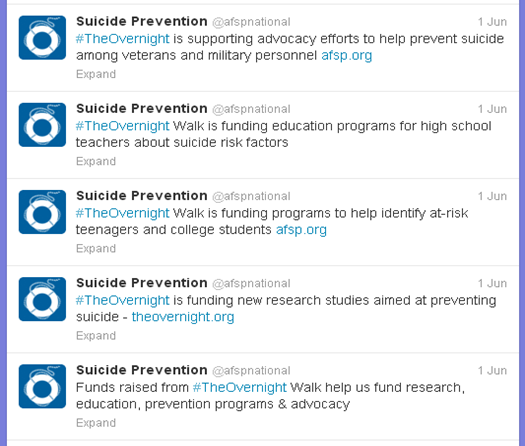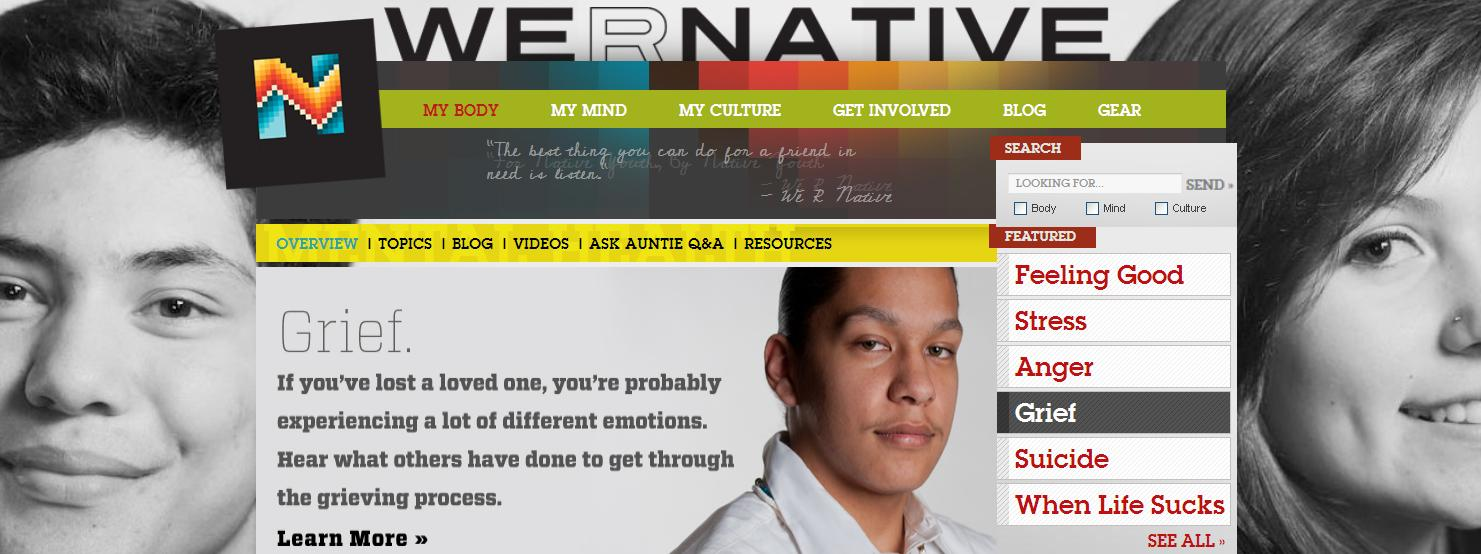These examples are designed to bring the Framework for Successful Messaging to life and inspire you to think about the four elements of Strategy, Safety, Positive Narrative, and Guidelines when developing or choosing your own messages and materials.
Please note:
- The examples are intended as inspiration; resist the urge to imitate or adopt others’ messaging without thinking through your own goals, audiences, and how it fits in with your overall efforts. In other words, always start with Strategy.
- While the Framework for Successful Messaging outlines core principles for developing messages that research tells us are more likely to be safe and effective, conducting evaluation is the only true test. Most of these examples weren’t evaluated, so unless the description mentions research outcomes, we simply don’t know whether or not they were effective in achieving their goals.
Facebook page focused on messages of future, hope, and life community is one component of the Pyramid Lake Paiute Tribe’s multi-faceted youth suicide prevention project.
What it is:
This is the official Facebook page for the Pyramid Lake Garrett Lee Smith Youth Suicide Prevention Project: “Kwetso’ina Numu” (People of Life) that is focused on promoting engagement and bringing messages of future, hope, and life to the community.
Strategy:
This Facebook page is aligned with the goals of the overall project, which promotes culturally congruent actions and activities that reinforce reasons for living and facilitate connectedness and coping. It serves as one component of a broader program for change that includes other project activities such as community events, trainings, a digital storytelling project, an “I Am LIFE” media campaign, and other efforts. The Facebook page (and also a YouTube channel) serves as a means to connect community members with the local activities and events, to reinforce positive and affirming messages that promote coping and community connection, and to highlight available resources such as the National Suicide Prevention Lifeline. The project chose social media channels that their audience already uses to increase the likelihood of participation.
Safety:
The posts on this page don’t normalize suicide in the community, portray it as heroic or honorable, or provide unsafe details about individual suicide deaths.
Positive Narrative:
Both the project as a whole and its Facebook page focus on positive themes such as living life well, connecting with others, and coping with challenges. For example, one series of posts encourages the audience to participate in creating a media campaign by completing phrases “I look forward to the future because…”, “Life is sacred because…“, “I have hope because…”, and “I am alive because…” While many of the posts don’t address suicide specifically, those that do have inspiring messages like “don’t give up” and include prevention resources such as the Lifeline number.
Guideline Example relevant to this type of message:
Guide to Choosing and Adapting Culturally and Linguistically Competent Health Promotion Materials
Also see resources in the Guidelines category Youth.
Visit the Facebook page and YouTube channel, which includes numerous digital stories.


Public statement about Suicide Prevention Month by Secretary Hagel describes DoD investments in prevention and treatment, encourages use of services, and emphasizes the importance of standing together to face challenges.
What it is:
A news release with a message from Secretary of Defense Chuck Hagel about Suicide Prevention Month posted on September 3, 2013.
Strategy:
The primary audience for this message is military service members and their families, with a secondary audience being the news-reading public. The apparent goals are to affirm top-level support for suicide prevention and to encourage and normalize help-seeking. It includes a clear call to action—to call the Military Crisis Line—and the necessary information and encouragement to do so (the phone number, and the fact that it’s confidential and available 24 hours, year-round). The language and framing are tailored to a military audience: for example, characterizing help-seeking as a choice that embodies courage, honor, and integrity.
Safety:
This message does not normalize or sensationalize the problem of suicide among service members and veterans and avoids reinforcing negative and inaccurate stereotypes about these populations (e.g., that few who face difficulties successfully cope with them.)
Positive Narrative:
Secretary Hagel’s remarks emphasize the actions the Department of Defense is taking, available services, and how military values support calling the Military Crisis Line and supporting one another. Rather than leaving the common impression that military suicide is an unstoppable epidemic, this statement emphasizes concrete solutions, available resources, and actions people can take.
Guideline Example relevant to this type of message:
This statement is a good example of providing the media with information that focuses on prevention and encouraging journalists to cover this part of the story. The guide Making Headlines: A Guide to Engaging the Media in Suicide Prevention in California and the other resources in the Guidelines category Working with News Media include information about how to work effectively with the media to promote prevention-focused coverage.
Read the full message from Secretary Hagel on the Air Force Medical Service website.
“Seeking behavioral health care is a choice that embodies moral courage, honor and integrity. Those values are at the foundation of what that we stand for and what we defend. The Military Crisis Line is there for all who need it. I encourage anyone in need to call 1-800-273-8255 and press ‘one’ to speak to a trained professional, 24 hours a day, 365 days a year. This service is confidential and available to all service members and their families.”
Organization shares a program success story on their blog: an employee who attended suicide prevention training vividly recounts how it enabled them to help their own child
What it is:
This blog post, which appeared on the Policy Research Associates (PRA) website, was written by a PRA employee who is also a parent. The parent describes attending a suicide prevention training and feeling interested but comfortably distant from the training content because it was aimed at a different professional audience. Nevertheless, the training successfully instilled the core message, which is to “ask” if you suspect someone is considering suicide. The post describes the parent’s surprise and gratitude at later noticing signs of depression in their own child and having the courage and knowledge to ask the questions and being able to get the right help.
Strategy:
This organization’s mission to “create positive social change” is front and center on its website. The blog post provides one small but vivid example of how PRA is achieving that aim. Sharing this programmatic success story serves multiple goals. The focus on positive outcomes positions the organization as effective and credible (an important message for funders, partners, potential program participants, and other stakeholders). It also supports broader prevention goals by illustrating how suicide prevention training can build the knowledge and skills needed to identify people at risk of suicide and connect them with services and supports. By describing the signs of depression and how to ask about suicide, the post incorporates information about when and how to act. It builds in motivation to learn these skills by highlighting the tangible benefits the parent received from the training. The post also prominently features the National Suicide Prevention Lifeline logo as a resource for immediate help. Having the parent tell their own story in the first person gives it authenticity and heart.
Safety:
This post does not include any unsafe content, such as making suicidal behavior seem romantic or attractive or oversimplifying its causes.
Positive Narrative:
This blog clearly conveys a Positive Narrative about suicide, specifically that there are actions people can take to help prevent it and that treatment can work. It also enables readers to picture vividly what the parent learned in the training and how the knowledge was translated into action.
Guideline Example relevant to this type of message:
For guidance on proactively and systematically gathering program success stories, see Impact and Value: Telling Your Program’s Story. While this resource was developed for oral health program managers, the content applies to any organization or program.
Read the full blog post.
“When I asked my child, “are you thinking of killing yourself?” and the answer was “yes,” I was so grateful that I had the courage and knowledge to ask the question. My child was relieved, as though a pressure had been lifted.”
National organization uses positive messaging to fundraise on social media.
What it is:
This series of tweets on June 1, 2013 from the American Foundation for Suicide Prevention (AFSP) features an array of AFSP programs and services that will be supported by funds raised through the Out of the Darkness Overnight Walk.
Strategy:
These messages are designed to achieve a specific operational goal: to raise funds for the organization. They are thoughtfully planned and timed, and include a specific call to action for the audience (to make donations). At the same time, these messages also advance a broader suicide prevention goal, which is to increase the public’s knowledge about the array of AFSP programs, policies, and services that exist to help prevent suicide.
Safety:
These messages avoid content that normalizes suicide or makes it seem unstoppable, such as providing dire statistics or using language like “epidemic.”
Positive Narrative:
These tweets send the overarching message that something can and is being done about suicide. The level of detail helps the public to picture what suicide prevention looks like in action.
Guideline Example relevant to this type of message:
Centers for Disease Control and Prevention’s Guide to Writing for Social Media
Also see resources in the Guidelines category Telling Others’ Stories.

WeRNative website for Native teens and young adults takes a positive messaging approach to addressing comprehensive health and wellness needs.
What it is:
This website is part of a multimedia health resource with content for Native youth, by Native youth. Geared to teens and young adults, the site provides content and stories about the topics that matter most to this audience. Issues addressed range from physical and sexual health to mental health and life skills. The project is managed by the Northwest Portland Area Indian Health Board.
Strategy:
The website is part of a broader multicomponent effort with defined goals: to address health and social issues important to Native youth, to promote holistic health and positive identity among Native teens and young adults, and to promote behavior change and community action. The project has a clearly defined audience (Native youth in WA, OR, and ID), and uses a mix of communication channels that are geared to reach that audience. The selection of channels was based on a survey of over 400 Native youth in the region to better understand how they use media technologies. The survey revealed that technology use by this audience was very common and quite diverse, so the project decided to launch a multimedia campaign that included the website, Facebook page, Twitter feed, YouTube channel, and text messaging service. The website provides a variety of useful resources and tools to encourage and enable the audience to take action to improve their wellness, connect with other Native youth in a safe virtual space, and take action in their communities. For example, action steps and tips are incorporated into each topic area. In addition, the “Get Involved” section of the website provides an opportunity to apply for mini-grants to support community service projects and showcases examples of Native teens and young adults doing great things in their communities.
Safety:
The content on this site avoids giving the impression that suicidal behavior in Native communities is more common than it actually is (i.e., “normalizing”) and avoids data or language that suggests that suicide is inevitable or unsolvable.
Positive Narrative:
WeRNative focuses on healthful living and encourages youth empowerment and help-seeking behavior, communicating a positive message to those who may be struggling with physical, sexual, or mental health concerns. It also showcases positive stories and highlights concrete actions that the audience can take to improve their own health and make a difference in their communities.
Guideline Example relevant to this type of message:
Engaging and Empowering Aboriginal Youth: A toolkit for service providers
Also see resources in the Guidelines category Culturally Specific Messaging
Visit the WeRNative website, view the project’s PowerPoint, or find them on Facebook, Twitter, YouTube, or text NATIVE to 24587 for weekly health tips, contests, and life advice.

Pagination
- 1
- 2
